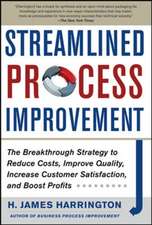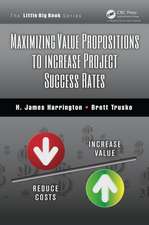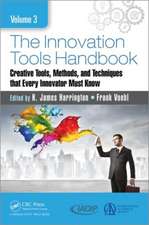The Innovation Tools Handbook, Volume 2: Evolutionary and Improvement Tools that Every Innovator Must Know
Autor H. James Harrington, Frank Voehlen Limba Engleză Hardback – 15 iul 2016
There is actually a growing body of evidence that indicates that looking outside of your company (rather than purely looking internally) and to customers’ needs, using the tools in this Handbook, will lead to more innovative ideas. Responding to customers’ needs is the key to a successful business. You can use these tools to talk to customers—satisfied ones, unsatisfied ones, potential customers, people who would never buy your product or service, and also people you have never considered as a potential customer. In addition, these tools will help you ask your competitors’ customers about what makes them happy with the current businesses and offerings in the industry, why they buy or do not buy from you, your competitors, and other industries. These tools will help you understand the steps in the customer journey they need to take, what delights and frustrates them, and what their pain points are.
The three volumes of The Innovation Tools Handbook cover 76 top-rated tools and methods, from the hundreds available, that every innovator must master to be successful. Covering evolutionary and/or improvement innovative tools and methodologies, Volume 2 presents 23 tools/methodologies related to innovative evolutionary products, processes, and services, or the improvement of existing ones.
For each tool, the book provides a definition, identifies the user of the tool, explains what phases of the innovation process the tool is used, describes how the tool is used, supplies examples of the outputs from the tool, identifies software that can maximize its effectiveness, and includes references and suggestions for further reading. Ideation is about developing ideas on how to seize identified opportunities. What are the possible answers to your breakthrough questions? Having a deep understanding about the customer, their needs and pain points, as well as the existing solutions (i.e. business models in the industry) will naturally lead to new ideas. How seriously you do your discovery homework using the tools in these Handbooks will determine not only how fast you create ideas, but about how likely these ideas are to succeed.
Tools and methodologies covered include: 5 why questions, Affinity diagrams, attribute listing, brainwriting 6–3–5, cause-and-effect diagrams, creative problem solving model, design for tools, flowcharting, force field analysis, Kano analysis, nominal group technique, plan–do–check–act, reengineering/redesign, reverse engineering, robust design, SCAMPER, simulations, six thinking hats, social networks, solution analysis diagrams, statistical analysis, tree diagram, and value analysis.
The authors believe that by making effective use of the tools and methodologies presented in this book, your organization can increase the percentage of creative/innovative ideas by five to eight times its present performance level.
Preț: 330.50 lei
Preț vechi: 428.13 lei
-23% Nou
Puncte Express: 496
Preț estimativ în valută:
63.24€ • 66.03$ • 52.34£
63.24€ • 66.03$ • 52.34£
Carte tipărită la comandă
Livrare economică 04-18 aprilie
Preluare comenzi: 021 569.72.76
Specificații
ISBN-13: 9781498760515
ISBN-10: 1498760511
Pagini: 452
Ilustrații: 152
Dimensiuni: 156 x 234 x 30 mm
Greutate: 0.79 kg
Ediția:1
Editura: Taylor & Francis
Colecția Productivity Press
Locul publicării:Oxford, United Kingdom
ISBN-10: 1498760511
Pagini: 452
Ilustrații: 152
Dimensiuni: 156 x 234 x 30 mm
Greutate: 0.79 kg
Ediția:1
Editura: Taylor & Francis
Colecția Productivity Press
Locul publicării:Oxford, United Kingdom
Public țintă
Professional Practice & DevelopmentCuprins
5 Whys. Affinity Diagrams. Attribute Listing, Morphological Analysis, and Matrix Analysis. Brainwriting 6–3–5. Cause-and-Effect Diagram. Creative Problem-Solving Model. Design for X. Flowcharting. Force Field Analysis. Kano Model. Nominal Group Technique. Plan–Do–Check–Act (Shewhart Cycle). Reengineering/Redesign. Reverse Engineering. Robust Design. SCAMPER. Simulations. Six Thinking Hats. Social Networks. Solution Analysis Methods Using FAST. Statistical Analysis. Tree Diagrams. Value Analysis (Value-Added Analysis). Appendix: Innovation Definitions. Index.
Notă biografică
Dr. H. James Harrington is the chief executive officer (CEO) of Harrington Management Systems. In the book Tech Trending, Dr. Harrington was referred to as "the quintessential tech trender." The New York Times referred to him as having a "… knack for synthesis and an open mind about packaging his knowledge and experience in new ways—characteristics that may matter more as prerequisites for new‑economy success than technical wizardry…." It has been said about him, "Harrington writes the books that other consultants use."
William Clinton, past president of the United States of America, appointed Dr. Harrington to serve as an Ambassador of Goodwill. Newt Gingrich, former Speaker of the House and general chairman of American Solutions, has appointed Dr. H. James Harrington to the advisory board of his Jobs and Prosperity Task Force.
Frank Voehl is the president of Strategy Associates. He serves as the chairman and president of Strategy Associates Inc. and as a senior consultant and chancellor for the Harrington Institute. He also serves as the chairman of the board for a number of businesses and as a Grand Master Black Belt instructor and technology advisor at the University of Central Florida in Orlando, Florida. He is recognized as one of the world leaders in applying quality measurement and Lean Six Sigma methodologies to business processes.
William Clinton, past president of the United States of America, appointed Dr. Harrington to serve as an Ambassador of Goodwill. Newt Gingrich, former Speaker of the House and general chairman of American Solutions, has appointed Dr. H. James Harrington to the advisory board of his Jobs and Prosperity Task Force.
Frank Voehl is the president of Strategy Associates. He serves as the chairman and president of Strategy Associates Inc. and as a senior consultant and chancellor for the Harrington Institute. He also serves as the chairman of the board for a number of businesses and as a Grand Master Black Belt instructor and technology advisor at the University of Central Florida in Orlando, Florida. He is recognized as one of the world leaders in applying quality measurement and Lean Six Sigma methodologies to business processes.
Descriere
This book is part of a three-book series designed to provide readers with the tools and methodologies that all innovators should be able to use. The Innovation Tools Handbook, Volume 2 presents 23 tools/methodologies related to innovative evolutionary products, processes, and services, or the improvement of existing ones. For each tool, the book provides a definition, identifies the user of the tool, explains what phases of the innovation process the tool is used, describes how the tool is used, supplies examples of the outputs from the tool, identifies software that can maximize its effectiveness, and includes references and suggestions for further reading.















